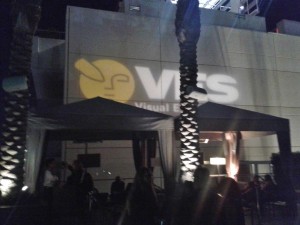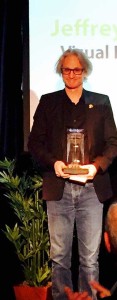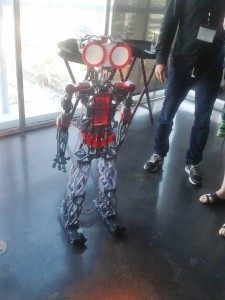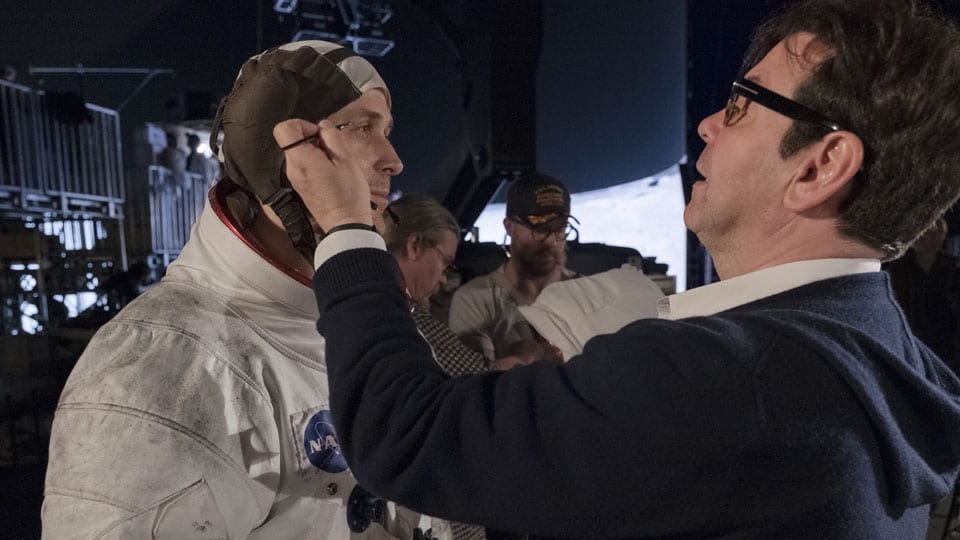 As if to literally denote it was scaling new heights, this year’s VES Summit was once again held at the W Hotel in Hollywood, but this time, on the roof. Or rather, in the lounge area on the top floor, just adjacent to the rooftop pool. The two groups – those immersed in water and lotion, and those immersed in discourse about immersive experiences – finally joined at sunset, as the Visual Effects Society sponsored a round of cocktails.
As if to literally denote it was scaling new heights, this year’s VES Summit was once again held at the W Hotel in Hollywood, but this time, on the roof. Or rather, in the lounge area on the top floor, just adjacent to the rooftop pool. The two groups – those immersed in water and lotion, and those immersed in discourse about immersive experiences – finally joined at sunset, as the Visual Effects Society sponsored a round of cocktails.
From breakfast to sunset, though, it was quite an intriguing day, as much for the actual content offered as for the thematic divergences from Summits past. Format-wise, VES stuck to a version of its recent scheduling, kicking off the day with a roundtable – small discussion groups that people pick for a morning and afternoon session each. But the number of such roundtables was scaled back in favor of more group panels and talks, and there you could sense the VES taking on new themes, perhaps expanding the very notion of what a visual effect is, and what its expanding role in 21st century storytelling might be.
One such programming surprise came in the first roundtable, led by Eric Bergez, VP of Swedish-based Intuitive Aerial, maker of industrial-strength drones. And yet drones would seem to be consigned to the realm of special effects – physical/mechanical ways of “getting the shot,” especially in circumstances where helicopters won’t work. But not so fast: Increasingly, they can be used – new regulations about operating them notwithstanding – for getting photographic plates making a wider range of visual effects work possible.
That was a conceit that led nicely to the morning’s first speaker, Dean Devlin, whose presence on a VES stage made complete sense, as he went over his own FX-laden career, wearing various producer, writer and director hats, from Stargate and Independence Day, to the genre TV show The Librarians, the upcoming Geostorm, and of course, the sequel to Independence Day.
He talked about how much better fractal work had gotten over the years, allowing CG to take over for things that had previously been done practically, especially involving fire or water. And now that filmmakers don’t have to “limit their imaginations,” the possibilities might be endless.
Even a TV show like The Librarians now boasts at least “a hundred effects shots per episode,” Devlin recounted.
Devlin talked about 3D filmmaking as being something not just akin “to adding color” in the transition from black-and-white, but instead “is a whole new language.” Which lead him to one of the day’s other themes – virtual reality, which Devlin said was not only a new language, but “insanely exciting.”
The hunt for immersive experiences kept cropping up throughout the day’s talks and panels. At the VR panel that followed after lunch, Mark Bolas, a director at the Mixed Reality Lab, and an assistant film professor at USC said we are on the cusp of “quantum transition,” and soon to experience seamless differences between our virtual work and play worlds. At the Games Storytelling roundtable lead by Naughty Dog’s Josh Scherr, the degree of “player agency” in the face of the overarching narrative was discussed.

As evening rolled around, there was also a series of honors VES wanted to bestow. These were for VES Fellows, providing “meritorious service to the society and the industry at large,” and were bestowed upon VFX supervisors Richard Hollander, Scott Squires and Jeffrey Okun (currently working with Devlin). There were also two lifetime memberships, given to Pacific Data Images founder Carl Rosendahl, whose company produced Antz and Shrek and Jeffrey Okun. But it was trifecta night for Okun, who also received a VES founders award, for any individual member of the society “who has significantly contributed to the success of the VES.”
At first jokingly citing Groucho Marx about not wanting to be part of any club that would have him for a member, Okun talked about visual effects artists being “charged with creating the dream that creates the future,” though he had some good anecdotes about the practicalities involved in such dreaming.
He mentioned being drawn to VES because “I wanted to be in a union.” Of course, VFX workers turned out to be avatars – so to speak – of the increasing numbers of non-unionized film workers deployed across the globe. Later, as a VES honcho, Okun said he met with IATSE’s Tom Short to see about getting FX wranglers unionized after all. Short’s reply was, “you want to see the bad side of a lead pipe?”
Okun said that since he was no longer on the VES board, he was a lot freer to recount such Hollywood tales out loud.
And there were less gritty practicalities scattered throughout the day, too. In the morning, Devlin said, “for me, there are way too many layers between filmmakers and visual effects artists.”
What kind of inefficiencies? Devlin thought filmmakers needed to commit earlier to what they wanted to do in previs (citing Gravity as a successful example of such commitment), so there would be less “butt covering” for people looking to justify their jobs in an expanded pre-to-postproduction pipeline. He also thought it would be helpful to look at VFX shots with as much sound – dialogue, effects, music – as was available, since that affected “where the eye goes.”

So here we are, a few millennia after the campfire “delivery system” has yielded to the Internet stream, and at the end of the day, Okun was recalling his apprenticeship with legendary Hollywood designer Saul Bass.
Bass was also directing then, and had spent the better part of a weekend splicing two different scenes together, one in front of the other, then back again. Frustrated, a young Okun said there were only two possible combinations there. Why was it taking so long?
Bass looked back at him and admonished that this wasn’t a mere edit. “I’m looking for the infinity of the universe,” he said.
Okun said he’d taken that search for the evanescent and transcendent with him in all his later work.





